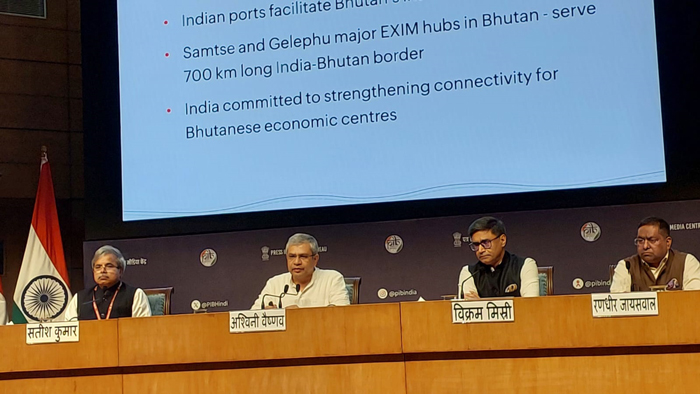Indian Railways to begin work on Kokrajhar-Gelephu and Banarhat-Samtse lines, landlocked Bhutan’s first-ever rail connections.
Six months after the official announcement during Prime Minister Narendra Modi’s state visit, India has confirmed the construction of two new railway lines to Bhutan, marking a historic step in cross-border connectivity with the “Land of the Thunder Dragon.”
Work on the Kokrajhar-Gelephu and Banarhat-Samtse corridors will commence shortly, according to Ashwini Vaishnaw, Union Minister for Railways, during a joint briefing with the Ministry of External Affairs on Monday.
“By constructing about 70 km [of the Kokrajhar-Gelephu line], you gain access to 150,000 km of the Indian Railways network. That’s the network effect. The construction period will be around four years. All land schedules and other formalities are complete. A lot of homework has gone into reaching this stage, and construction will begin very soon,” Vaishnaw said during a media briefing.
The Kokrajhar-Gelephu line, spanning approximately 69 km, has been declared a Special Railway Project (SRP) under the Railways Act, 1989, and will be implemented by the Northeast Frontier Railway (NFR) at an estimated cost of ₹35 billion. The line is expected to take around four years to complete.
The Banarhat-Samtse line (16 km), connecting West Bengal to Bhutan’s emerging industrial hub of Samtse, will cost ₹5.77 billion and is expected to be completed in three years.
“This will bring huge benefits to the people of Bhutan. Goods movement, which currently takes days, will happen within hours,” Vaishnaw added.
These first-ever rail connectivity projects for Bhutan are expected to bolster India’s Act East policy, strengthen frontier infrastructure and national security, and facilitate trade, tourism, and regional integration.
Frontier Infrastructure Gains Ground
India remains Bhutan’s largest development partner, particularly in infrastructure and economic growth.
Vikram Misri, Foreign Secretary, Ministry of External Affairs, noted, “For Bhutan’s 13th Five-Year Plan (2024–29), the Government of India has committed ₹100 billion in support, covering project-tied assistance, high-impact community development projects, the economic stimulus programme, and a programme grant. This represents a 100 per cent increase over the 12th Plan allocation.”
India is also Bhutan’s top trading partner, accounting for nearly 80 per cent of its total trade. The 2016 bilateral agreement on trade, commerce and transit ensures duty-free access for Bhutan to and from third countries via Indian territory, making connectivity a shared priority.
Misri added that Bhutan’s flagship Gelephu Mindfulness City project—bordering Assam—is being developed under the direct guidance of the King of Bhutan. Envisioned as a regional economic hub, the initiative has received India’s full support.
“Similarly, Samtse, which borders West Bengal, is being developed as a key industrial town for manufacturing and export. These rail links will be critical for enhancing passenger and cargo movement,” Misri said.
The twin rail projects are expected to significantly boost tourism, industrial growth, and people-to-people exchanges, cementing India’s role in Bhutan’s next phase of development. More than physical infrastructure, the rail links represent a diplomatic and economic bridge between two neighbours with deep historic and cultural ties.


